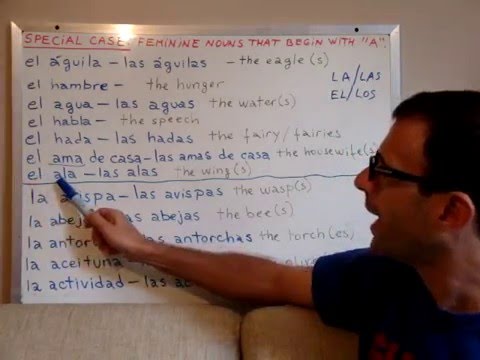Spanish lesson #121: In this class I’ll speak about the special case of the feminine nouns that begin with letter “A”, and which generally (although not always) go with the masculine article “el” when in the singular form, instead of the feminine article “la”.
You can see a full list of all the video lessons by clicking on List of Lessons on the Main Menu.
Although we are focussing more on vocabulary and grammar, pay attention to the Spanish pronunciation in these video lessons, and remember to practice repeating the same words and sounds.
To make the video-screen larger, click on the right icon on the lower right corner of the video.














From wordreference.com: Note: Inmediatamente antes de un sustantivo femenino singular que empiece con “a” o “ha” tónicas, se emplean los artículos “el” y “un”.
I think you should point out the rule for when to use “el” or “un”. It only is used when the stress is on the first “a”. So rather than just guess when you run into an unfamiliar word, you should base the use of “el” on where the stress is.
Hi Steven. I did mention it in at least one of my video-lessons. This rule is not exact. It is a “half rule”. I’ll show you a few examples that don’t follow it:
la aceituna (the olive) – una aceituna
la alcancía (the piggy bank) – una alcancía
la hamaca (the swing) – una hamaca
la hacienda (the ranch) – una hacienda
I can keep going. There are at least hundreds of words that don’t fall within this rule.